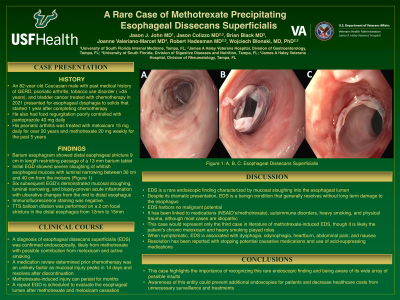Sunday Poster Session
Category: Esophagus
P0460 - A Rare Case of Methotrexate Precipitating Esophageal Dissecans Superficialis
Sunday, October 22, 2023
3:30 PM - 7:00 PM PT
Location: Exhibit Hall

Has Audio

Jason John, MD
USF Health
Tampa, FL
Presenting Author(s)
Jason John, MD1, Jason Colizzo, MD1, Brian Black, MD2, Joanne Valeriano-Marcet, MD1, Robert Hadesman, MD3, Wojciech Blonski, MD, PhD4
1USF Health, Tampa, FL; 2University of South Florida Morsani College of Medicine, Tampa, FL; 3James A. Haley Veteran's Hospital, Tampa, FL; 4James A. Haley Veteran's Hospital and USF Health, Tampa, FL
Introduction: Esophageal Dissecans Superficialis (EDS) is a rare endoscopic finding characterized by mucosal sloughing into the esophageal lumen. While harboring no malignant potential, its etiology is yet to be elucidated.
Case Description/Methods: An 82-year-old Caucasian male with past medical history of GERD, psoriatic arthritis, tobacco use disorder ( >35 years), and bladder cancer treated with chemotherapy in 2021 presented for esophageal dysphagia to solids that started 1 year after completing chemotherapy. He also had food regurgitation poorly controlled with pantoprazole 40 mg daily. His psoriatic arthritis was treated with meloxicam 15 mg daily for over 20 years and methotrexate 20 mg weekly for the past 5 years. Barium esophagram showed distal esophageal stricture 9 cm in length restricting passage of a 13 mm barium tablet. Initial EGD showed severe sloughing of whitish esophageal mucosa with luminal narrowing between 30 cm and 40 cm from the incisors (Fig 1). Six subsequent EGD’s demonstrated mucosal sloughing, luminal narrowing, and biopsy-proven acute inflammation with ulcerative changes from the mid to distal esophagus. Immunofluorescence staining was negative. TTS balloon dilation was performed on a 2 cm focal stricture in the distal esophagus from 12mm to 15mm. A diagnosis of EDS was confirmed endoscopically, likely from methotrexate with possible contribution from meloxicam and active smoking. A medication review determined prior chemotherapy was an unlikely factor as mucosal injury peaks in 14 days and resolves after discontinuation. Methotrexate-induced injury can persist for months. A repeat EGD is scheduled to evaluate the esophageal lumen after methotrexate and meloxicam cessation.
Discussion: Despite its dramatic presentation, EDS is a benign condition that generally resolves without long term damage to the esophagus. It has been linked to medications (NSAID’s/methotrexate), autoimmune disorders, heavy smoking, and physical trauma, although most cases are idiopathic. This case would represent only the third case in literature of methotrexate-induced EDS, though it is likely the patient’s chronic meloxicam and heavy smoking played roles. When symptomatic, EDS is associated with dysphagia, odynophagia, heartburn, abdominal pain, and nausea. Resolution has been reported with stopping potential causative medications and use of acid-suppressing medications. This case highlights the importance of recognizing this rare endoscopic finding and being aware of its wide array of possible insults.

Disclosures:
Jason John, MD1, Jason Colizzo, MD1, Brian Black, MD2, Joanne Valeriano-Marcet, MD1, Robert Hadesman, MD3, Wojciech Blonski, MD, PhD4. P0460 - A Rare Case of Methotrexate Precipitating Esophageal Dissecans Superficialis, ACG 2023 Annual Scientific Meeting Abstracts. Vancouver, BC, Canada: American College of Gastroenterology.
1USF Health, Tampa, FL; 2University of South Florida Morsani College of Medicine, Tampa, FL; 3James A. Haley Veteran's Hospital, Tampa, FL; 4James A. Haley Veteran's Hospital and USF Health, Tampa, FL
Introduction: Esophageal Dissecans Superficialis (EDS) is a rare endoscopic finding characterized by mucosal sloughing into the esophageal lumen. While harboring no malignant potential, its etiology is yet to be elucidated.
Case Description/Methods: An 82-year-old Caucasian male with past medical history of GERD, psoriatic arthritis, tobacco use disorder ( >35 years), and bladder cancer treated with chemotherapy in 2021 presented for esophageal dysphagia to solids that started 1 year after completing chemotherapy. He also had food regurgitation poorly controlled with pantoprazole 40 mg daily. His psoriatic arthritis was treated with meloxicam 15 mg daily for over 20 years and methotrexate 20 mg weekly for the past 5 years. Barium esophagram showed distal esophageal stricture 9 cm in length restricting passage of a 13 mm barium tablet. Initial EGD showed severe sloughing of whitish esophageal mucosa with luminal narrowing between 30 cm and 40 cm from the incisors (Fig 1). Six subsequent EGD’s demonstrated mucosal sloughing, luminal narrowing, and biopsy-proven acute inflammation with ulcerative changes from the mid to distal esophagus. Immunofluorescence staining was negative. TTS balloon dilation was performed on a 2 cm focal stricture in the distal esophagus from 12mm to 15mm. A diagnosis of EDS was confirmed endoscopically, likely from methotrexate with possible contribution from meloxicam and active smoking. A medication review determined prior chemotherapy was an unlikely factor as mucosal injury peaks in 14 days and resolves after discontinuation. Methotrexate-induced injury can persist for months. A repeat EGD is scheduled to evaluate the esophageal lumen after methotrexate and meloxicam cessation.
Discussion: Despite its dramatic presentation, EDS is a benign condition that generally resolves without long term damage to the esophagus. It has been linked to medications (NSAID’s/methotrexate), autoimmune disorders, heavy smoking, and physical trauma, although most cases are idiopathic. This case would represent only the third case in literature of methotrexate-induced EDS, though it is likely the patient’s chronic meloxicam and heavy smoking played roles. When symptomatic, EDS is associated with dysphagia, odynophagia, heartburn, abdominal pain, and nausea. Resolution has been reported with stopping potential causative medications and use of acid-suppressing medications. This case highlights the importance of recognizing this rare endoscopic finding and being aware of its wide array of possible insults.

Figure: Fig 1: EDS
Disclosures:
Jason John indicated no relevant financial relationships.
Jason Colizzo indicated no relevant financial relationships.
Brian Black indicated no relevant financial relationships.
Joanne Valeriano-Marcet indicated no relevant financial relationships.
Robert Hadesman indicated no relevant financial relationships.
Wojciech Blonski indicated no relevant financial relationships.
Jason John, MD1, Jason Colizzo, MD1, Brian Black, MD2, Joanne Valeriano-Marcet, MD1, Robert Hadesman, MD3, Wojciech Blonski, MD, PhD4. P0460 - A Rare Case of Methotrexate Precipitating Esophageal Dissecans Superficialis, ACG 2023 Annual Scientific Meeting Abstracts. Vancouver, BC, Canada: American College of Gastroenterology.
